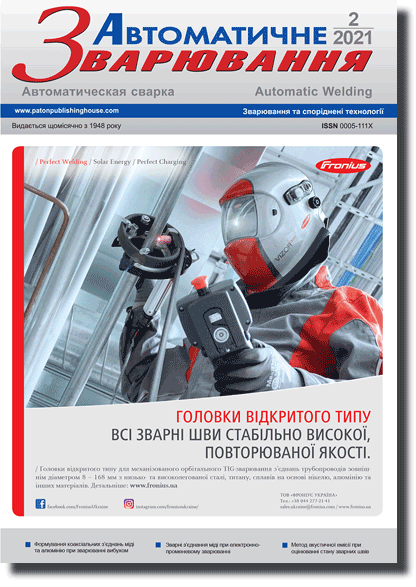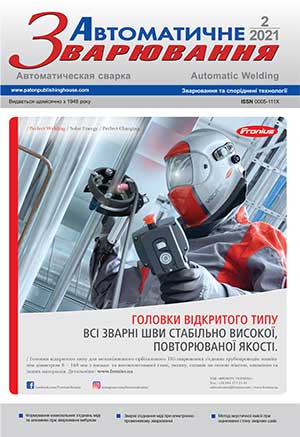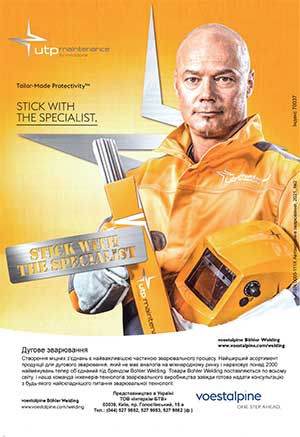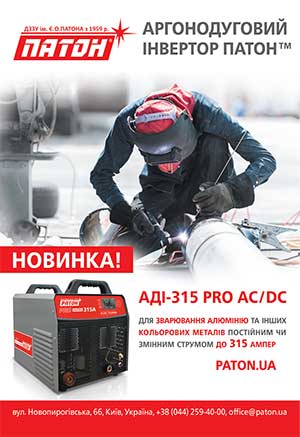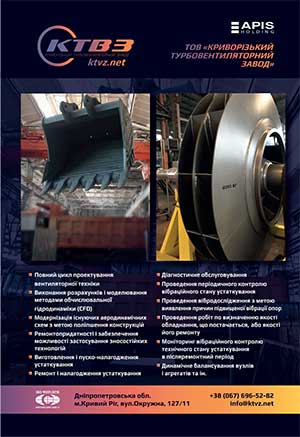| 2021 №02 (03) |
DOI of Article 10.37434/as2021.02.04 |
2021 №02 (05) |
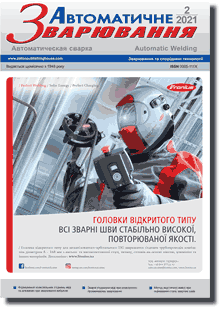
"Avtomatychne Zvaryuvannya" (Automatic Welding), #2, 2021, pp. 22-31
Influence of heat treatment on the properties of welded joints of V1341 alloy under modeled operating conditions
L.I. Nyrkova, Т.M. Labur, S.O. Osadchuk, М.R. Yavorska, V.A. Koval
E.O. Paton Electric Welding Institute of the NAS of Ukraine. 11 Kazymyr Malevych Str., 03150, Kyiv, Ukraine. E-mail: office@paton.kiev.ua
The paper presents the results of comparative studies of corrosion-mechanical resistance of welded joints of V1341 alloy 1.2 mm thick, produced by manual argon-arc welding with free and constricted arc, after different types of heat treatment (HT) – artificial aging and full cycle heat treatment (hardening and artificial aging). It was shown that artificial aging increases the strength characteristics of welded joints: those produced by free arc - by ~23%, compared to the base metal, by constricted arc – by ~29%, but reduces the relative elongation by ~82% and ~84%, and the strength coefficient – to 0.77 and 0.71 (0.81 and 0.83 in as-welded state), respectively. The full cycle of HT provides increase in both strength and ductility. After artificial aging, as well as after a complete heat treatment cycle, the potential difference between the base metal and the HAZ does not exceed the permissible value of 0.05 V (according to GOST 9.005), which will not be dangerous at operation in non-aggressive environments. Artificial aging and full HT cycle do not impair the resistance of welded joints of VB1341T alloy to exfoliating corrosion compared to as-welded state, which is assessed as value 2. An increase of resistance to intercrystalline corrosion (ICC) after artificial aging was demonstrated, the maximum depth of which was 0.301 mm for the joint produced by a free arc, and 0.233 mm – for a joint produced by a constricted arc (in as-welded state it was 0.350 mm and 0.47 mm, respectively). After a complete HT cycle, the ICC depth was 0.287 mm and 0.345 mm, respectively. Artificial aging reduces the corrosion-mechanical resistance of welded joints produced by free and constricted arc: the time to fracture of the samples was 9 and 12 days, respectively (compared to 45 days in as-welded state), but after a full cycle of HT maximum time to fracture of welded joints increased to 54 and 31 days, respectively. Welded joints produced by a constricted arc had higher corrosion-mechanical resistance after a complete heat treatment cycle. 14 Ref., 5 Tabl., 7 Fig.
Keywords: aluminum alloy, welded joints produced by free and constricted arc welding, mechanical properties, structure, intercrystalline corrosion, exfoliating corrosion, corrosion under constant strain, potentiometry, voltamperometry
Received: 18.01.2021
References
1. Ishchenko, A.Ya., Labur, T.M. (2012) Welding of modern structures of aluminium alloys. Kyiv, Naukova Dumka [in Russian].2. Krivov, G.A., Ryabov, V.R., Ishchenko, A.Ya. et al. (1998) Welding in aircraft construction. MIIVTs [in Russian].
3. Ovchinnikov, V.V., Grushko, O.E. (2005) High performance welded aluminium alloy V1341 of Al-Mg-Si system. Mashinostroenie i Inzhen. Obrazovanie, 3(4), 2–11 [in Russian].
4. Albert, D. (1993) Aluminium alloys in arc welded constructions. Welding World Magazine, 32(3), 97–114.
5. Pogatscher, S., Antrekowitsch, H., Leitner, H. et al. (2013) Influence of the thermal route on the peak-aged microstructures in an Al-Mg-Si aluminum alloy. Scripta Mater., 68, 158-161. https://doi.org/10.1016/j.scriptamat.2012.10.006
6. Fridlyander, I.N., Grushko, O.E., Shamraj, V.F., Klochkov, G.G. (2007) High-strength structural alloy Al-Cu-Li-Mg of lower density doped with silver. Metallovedenie i Termich. Obrab. Metallov, 6, 3-7 [in Russian].
7. Koval, V.A., Labur, T.M., Yavorska, T.R. (2020) Properties of joints of V1341T grade alloy under the conditions of TIG welding. The Paton Welding J., 2, 35-40. https://doi.org/10.37434/tpwj2020.02.07
8. Nyrkova, L.I., Labur, T.M., Osadchuk, S.O., Yavorska, T.R. (2020) Corrosion and mechanical resistance of welded joints of aluminium B1341 alloy, produced by argon arc welding using free and constricted arc. Ibid., 12, 40-47. https://doi.org/10.37434/tpwj2020.12.06
9. Nyrkova, L.I., Osadchuk, S.O., Kovalenko, S.Yu. et al. (2020) Influence of heat treatment on corrosion resistance of welded joint of aluminium alloy of Al–Mg–Si–Сu system. Fizyko-Khimich. Mekhanika Materialiv, 5, 131–138 [in Ukrainian].
10. GOST 9.021-74: Unified system of corrosion and ageing protection. Aluminium and aluminium alloys. Accelerated test methods for intercrystalline corrosion. Moscow, Izd-vo standartov [in Russian].
11. GOST 9.904-83: Unified system of corrosion and ageing protection. Aluminium and aluminium alloys. Accelerated test methods for exfoliation corrosion. Moscow, Izd-vo standartov [in Russian.
12. GОСТ 9.019-74: Unified system of corrosion and ageing protection. Aluminium and magnesium alloys. Accelerated test methods for corrosion cracking. Moscow, Izd-vo standartov [in Russian].
13. GОСТ 9.005-72: Unified system of corrosion and ageing protection. Metals, alloys, metallic and non-metallic coatings. Permissible and impermissible contacts with metals and non-metals. Moscow, Izd-vo standartov [in Russian].
14. Zhuk, N.P. (1976) Course of theory of corrosion and protection of metals. Moscow, Metallurgiya [in Russian].
Advertising in this issue:
The cost of subscription/purchase order journals or individual articles
| Journal/Currency | Annual Set | 1 issue printed |
1 issue |
one article |
| TPWJ/USD | 384 $ | 32 $ | 26 $ | 13 $ |
| TPWJ/EUR | 348 € | 29 € | 24 € | 12 € |
| TPWJ/UAH | 7200 UAH | 600 UAH | 600 UAH | 280 UAH |
| AS/UAH | 1800 UAH | 300 UAH | 300 UAH | 150 UAH |
| AS/USD | 192 $ | 32 $ | 26 $ | 13 $ |
| AS/EUR | 180 € | 30 € | 25 € | 12 € |
| SEM/UAH | 1200 UAH | 300 UAH | 300 UAH | 150 UAH |
| SEM/USD | 128 $ | 32 $ | 26 $ | 13 $ |
| SEM/EUR | 120 € | 30 € | 25 € | 12 € |
| TDNK/UAH | 1200 UAH | 300 UAH | 300 UAH | 150 UAH |
| TDNK/USD | 128 $ | 32 $ | 26 $ | 13 $ |
| TDNK/EUR | 120 € | 30 € | 25 € | 15 € |
AS = «Automatic Welding» - 6 issues per year;
TPWJ = «PATON WELDING JOURNAL» - 12 issues per year;
SEM = «Electrometallurgy Today» - 4 issues per year;
TDNK = «Technical Diagnostics and Non-Destructive Testing» - 4 issues per year.





